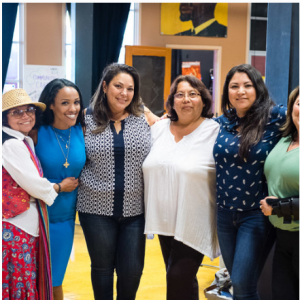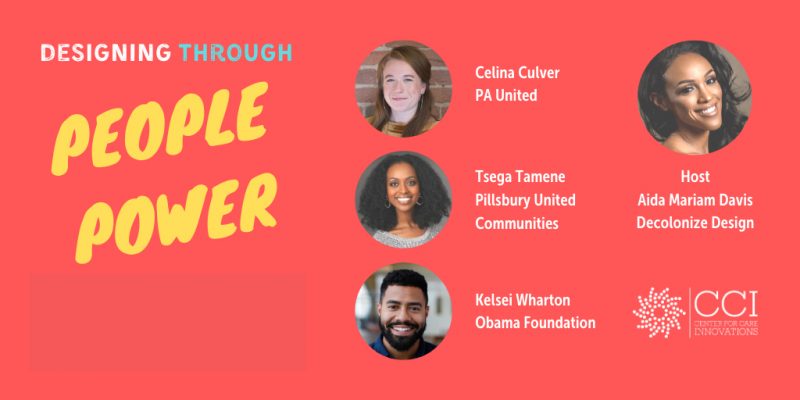This week we hosted “Designing Through People Power,” which focused on combining design and community organizing for change that is transformative and socially just.
The webinar grew out of a discussion about “design thinking,” a dynamic innovation tool that can dehumanize whole communities if used the wrong way. But if we combine design thinking with community organizing – a powerful strategy for building people power and righting injustices – it can transform the well-being of our most vulnerable communities.
Nearly 200 people attended the webinar, moderated by co-host Aida Mariam Davis, the CEO and founder of Decolonize Design (Los Angeles, CA). Davis has years of experience that spans community and labor organizing, campaign management, leadership development, design thinking methods, and policy consulting.
The other co-hosts, who brought additional expertise in integrating design with grassroots and community organizing, were:
- Celina Culver of Pennsylvania United & the Voice of Westmoreland l Western PA
- Tsega Tamene of Pillsbury United Communities l Minneapolis, MN
- Kelsei Wharton of the Obama Foundation l Washington, DC
Along with strategies, the four experts shared their own grief and pain over George Floyd’s death and the passion they bring to their work, which inspired an outpouring of questions, applause, and thanks in the chat box.
WHO SHOULD WATCH THIS WEBINAR?
Anyone who wants to learn more about how to do effective design thinking that builds power for communities and uproots racial and ethnic discrimination embedded in health care and other systems.
Our Top Five Takeaways
1. When doing design work in a community, let the community take the lead.
“Often we see a top-down approach to developing prototypes and iterations for [community] design, one that are developed by nonprofits or academics,” said Culver. “But if we use the tools of community organizing to guide our work, we know that the best solutions are developed by the community.”
As an example, she points to the Parent Innovation Institute in Oakland, Calif., where she worked with Davis to co-design projects with parents and teachers. In one project, moms wanted to fathers to be more active and created Days for Daddies. But as they learned more about design thinking, Culver said, they realized that on those days, they themselves too often acted as barriers between dads and their kids.
“The moms then went on to incorporate a self-care element, in which they could relax and enjoy talking with each other while the dads and their kids played together,” Culver said – sessions that worked out well for all concerned. The group’s leader underwent a transformation from a shy woman to a strong advocate for better conditions at her children’s school. “This wasn’t about adopting other people’s ideas,” said Culver, “but about learning how to tell her own story and find her own power.”
The bottom line: Rather than trying to design in a vacuum, partner with grassroots groups who can do generative community work.

Aida Miriam Davis (second from left) after a co-design session with community members (Decolonize Design)
2. Lift up those who are most impacted.
“We’re in a dual public health crisis – the pandemic of police violence and anti-Blackness and the pandemic of COVID-19,” Davis observed. Tamene agreed, adding that both COVID and police violence have disproportionately harmed communities of color. “We’re all hurting right now, but we’re not all hurting the same,” she said. “We need to lift up and resource folks who are most impacted. It’s a struggle to shift power that frees us all. We have the capacity, if the courage, to survive this. In a moment that spans history and time, we’ve got to act, as abolitionist Mariame Kaba said, with the urgency of the moment and the patience of a thousand years.”
Discussing her work in Minneapolis, Tamene continued: “We’re feeling a real and familiar grief and trauma and fear in witnessing the murder of our brother George Floyd… and a lot of us are holding that in our bodies and our minds and our spirits… There’s a lot of hurt, but at the same time, we are experiencing the hope and vision and resilience and the crazy imagination that is required for our collective liberation and our healing. I was overwhelmed by the outpouring of love and support for our Twin Cities. At the same time, I’m not interested in ‘performative love’ that doesn’t require action. If we‘re outraged and practicing empathy in this moment, we have to be called to action.”
3. Dismantling a toxic system requires deep, sustained relationships with community members.
An anti-Black system and the idea of white supremacy is held up by design, the co-hosts agreed. To uproot it, Wharton noted, requires more than the empathy required in regular design thinking. Instead, designers’ relationships with community members “should not be confined to a few hours or a few forums or community meetings,” he said. “These relationships should be deep and sustained over a long period of time. The beauty of community is getting to know people who’ve been overlooked and who often don’t have a seat at the table.” Such community organizing over a long period of time, Wharton said, “builds power for people who lack voice to have the opportunity be intimately involved in designing new futures and new realities.”
Culver added that leadership development is also critical when fusing design with community organizing, recalling a time in her organization in which meetings were perfunctory –“focused on logistics and scheduling but not [at] the core of transforming our communities.” After developing ten consistent leaders from the community, however, the meetings became energetic and transformative, with the leaders holding her and the group accountable. “It’s always better when people are supported to use their own power,” she said.
4. In this uprising, look to youth and Black voices.
Besides grassroots-, faith-based- and broad-based organizing, Wharton said, “what we’re seeing during this time is the power of digital tools at our disposal… that allow us to work at depth and scale. The Black Lives Matter movement, for example, would not be where it is without the amplification, the conversations, the Zoom meetings and tweetstorms that let people know of tangible acts they could take.” Millennials and Gen Z, he said, seem more open to an ongoing leaderless movement, and he and other co-hosts urged support for youth and Black voices and investing in local leadership.
5. When we talk about value-based care, we need to start by defining those values.
Poll after poll shows that healthcare is an issue that transcends political party lines, according to Culver, who reports that our broken healthcare system is inspiring widespread conversation and activism. What if health care had to take into account equity measures? Like a recent medical journal commentary, at least one participant noted that too much emphasis on valued-based health care competition “tends to neglect patients’ own values,” among other things. The journal suggested value-driven health care instead, which would take patients’ own values as both prescriptive and guiding.
Learn More:
-
- Field Guide: Equity Centered Community Design. Equity Centered Community Design (ECCD) “acknowledges and utilizes the role of people + systems + power when developing solutions or approaches that impact the many.”
- Washington, Harriet. Medical Apartheid. New York, New York: Harlem Moon, 2006. A history of Black America’s unwitting use as medical subjects in U.S. medicine.
- Brown, Adrienne Maree. Emergent Strategy: Shaping Change, Shaping Worlds. AK Press, 2017.
- “The tragic death of George Floyd reveals continuing problem with police violence.” Equal Rights Initiative. Montgomery, Alabama.
Find this useful or interesting? We’re constantly sharing stuff like this. Sign up to receive our newsletter to stay in the loop.

